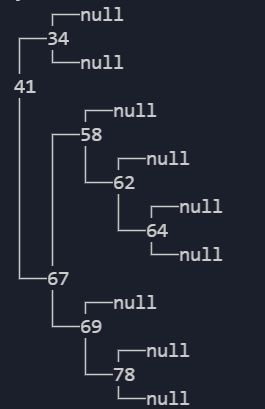c++可视化 横向打印二叉树(连线、规整)
2022年12月9日更新:新帖链接
c++可视化 横向打印二叉树(连线、规整)_岚花落_的博客-CSDN博客
最近本人在和 avl 树、红黑树进行“友好交流”,特此水一篇可视化辅助。直接放结果 :
一、 二叉树实现
#include
#include
using namespace std;
#define MAX_SIZE 1000
struct node
{
int key;
int l, r;
};
node tree[MAX_SIZE] = {{0, 1, 0}};
int cnt;
void add(int key, int &root = tree[0].l)
{
if (root == 0)
{
root = ++cnt;
tree[cnt] = {key};
}
else if (key < tree[root].key)
add(key, tree[root].l);
else
add(key, tree[root].r);
}
二、打印函数
#include
#include
using namespace std;
inline void trans(vector &x, string before, string after)//转换第一个匹配的字符串
{
for (auto &p : x)
if (p == before)
{
p = after;
break;
}
}
void show(int root, vector pre = vector(0))
{
auto &p = tree[root];
if (p.key != 0)
{
vector temp(pre);
trans(temp, "┌──", " ");
trans(temp, "└──", "│ ");
temp.push_back("┌──");
show(p.l, temp);
}
for (auto &i : pre)
cout << i;
if (p.key == 0)
cout << "null" << endl;
else
cout << p.key << endl;
if (p.key != 0)
{
vector temp(pre);
trans(temp, "┌──", "│ ");
trans(temp, "└──", " ");
temp.push_back("└──");
show(p.r, temp);
}
}
// cout << string("┌──").size() << endl;
// cout << string("├──").size() << endl;
// cout << string("└──").size() << endl;
// cout << string("│ ").size() << endl;
// cout << string(" ").size() << endl;
三、完整代码
更新:引入删除功能
#include
#include
#include
using namespace std;
#define MAX_SIZE 1000
struct node
{
int key;
int l, r;
};
node tr[MAX_SIZE] = {{0, 0, 1}};
int cnt;
void add(int key, int &root = tr[0].r)
{
if (root == 0)
{
root = ++cnt;
tr[cnt] = {key, 0, 0};
}
else if (key < tr[root].key)
add(key, tr[root].l);
else if (key > tr[root].key)
add(key, tr[root].r);
}
void del(int key, int &root = tr[0].r)
{
if (root == 0)
return;
auto &p = tr[root];
if (key < p.key)
del(key, p.l);
else if (key > p.key)
del(key, p.r);
else
{
if (p.l == 0 && p.r == 0)
root = 0;
else if (p.l == 0 && p.r != 0)
root = p.r;
else if (p.l != 0 && p.r == 0)
root = p.l;
else if (tr[p.r].l == 0) //后继是右子树的根
{
tr[p.r].l = p.l;
root = p.r;
}
else
{
int last = root;
root = p.r;
while (tr[root].l != 0) //找右子树的最小值,维护父指针last
{
last = root;
root = tr[root].l;
}
tr[last].l = tr[root].r;
tr[root].l = p.l;
tr[root].r = p.r;
}
}
}
//
void show(int root = 1, vector pre = vector(0));
int main()
{
srand(time(0));
for (int i = 1; i <= 20; ++i)
add(rand() % 100);
show();
int ch = 1;
do
{
int temp;
puts("请输出操作码:");
puts("1:打印");
puts("2:删除");
puts("0:退出");
cin >> ch;
if (ch == 1)
show();
else if (ch == 2)
{
cin >> temp;
del(temp);
}
} while (ch);
}
inline void trans(vector &x, string before, string after)
{
for (auto &p : x)
if (p == before)
{
p = after;
break;
}
}
void show(int root, vector pre)
{
auto &p = tr[root];
if (p.key != 0)
{
vector temp(pre);
trans(temp, "┌──", " ");
trans(temp, "└──", "│ ");
temp.push_back("┌──");
show(p.l, temp);
}
for (auto &i : pre)
cout << i;
if (p.key == 0)
cout << "null" << endl;
else
cout << p.key << endl;
if (p.key != 0)
{
vector temp(pre);
trans(temp, "┌──", "│ ");
trans(temp, "└──", " ");
temp.push_back("└──");
show(p.r, temp);
}
}
// cout << string("┌──").size() << endl;
// cout << string("├──").size() << endl;
// cout << string("└──").size() << endl;
// cout << string("│ ").size() << endl;
// cout << string(" ").size() << endl;
